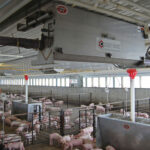Massey Ferguson 2170XD Baler Update 4
Greetings, my name is Harvey Stushnoff, Product Specialist for AGCO. I am here to give a brief update on one of the Massey Ferguson 2170XD (Xtra-Density) balers that has been operating in the Wilmette Valley, Oregon for the past 60...
Massey Ferguson 2170XD Baler Update 4
Greetings, my name is Harvey Stushnoff, Product Specialist for AGCO. I am here to give a brief update on one of the Massey Ferguson 2170XD (Xtra-Density) balers that has been operating in the Wilmette Valley, Oregon for the past 60... Greetings, my name is Harvey Stushnoff, Product Specialist for AGCO. I am here to give a brief update on one of the Massey Ferguson 2170XD (Xtra-Density) balers that has been operating in the Wilmette Valley, Oregon for the past 60 days. Our primary goal with this unit was to produce as many bales as possible in a short time frame as an endurance test of the machines reliability.
Greetings, my name is Harvey Stushnoff, Product Specialist for AGCO. I am here to give a brief update on one of the Massey Ferguson 2170XD (Xtra-Density) balers that has been operating in the Wilmette Valley, Oregon for the past 60 days. Our primary goal with this unit was to produce as many bales as possible in a short time frame as an endurance test of the machines reliability.I am happy to report that we were able to produce 12,989 bales in 60 days in 196 working hours – not including transport or headland turning time. That is an impressive average baling rate of 66.27 bales per hour or slightly more than one bale per minute. This was done in some of the tougher baling conditions like baling rye and fescue grass straw after it has been combined. These are high volume and very dry crops often averaging only 3% moisture content. The numbers speak for themselves as a testimony to the machine’s reliability.
The next goal was to measure and collect data with respect to increased bale weights versus our current production 3×4 balers. In this valley the grass straw is baled then repressed into an even heavier package that is shipped overseas to an export market. The key to the success of a machine for this market is to reduce the handling by reducing the number of bales that need to be hauled to the stationary presses and processed by these presses in turn reducing the operating costs of the producers.
Getting consistent weight data was bit of a challenge due to the desire to have as many operators as possible try this machine, each with varying strengths of twine. All in all if we looked at the data for the bales made when using a high knot strength twine we saw bale weights with an approximate 20% while being baled at an average speed of 5+ mph. The advantage of using many operators in different conditions with a baler that is equipped with a scale and moisture system was that it let us look at every bale weight and moisture content so we could derive some true and accurate averages.
Over 30 customers who were given the opportunity to try this baler had very favorable comments giving it a promising future to be able to increase the efficiency of our producers. With the grass straw season winding down, the baler will be moving eastward to be tested in other crops such as hay forage, grain straw, and cornstalks for the rest of the 2010 season. Stayed tuned for future updates on the success of this exciting new product. In the meantime, check out some photos from the field below.



